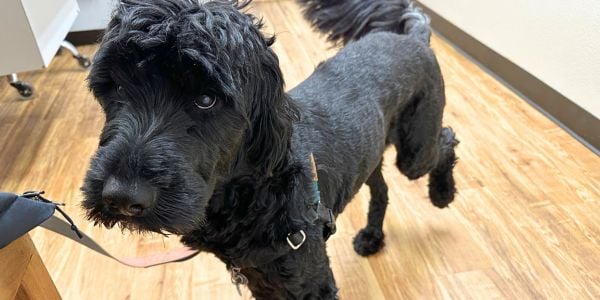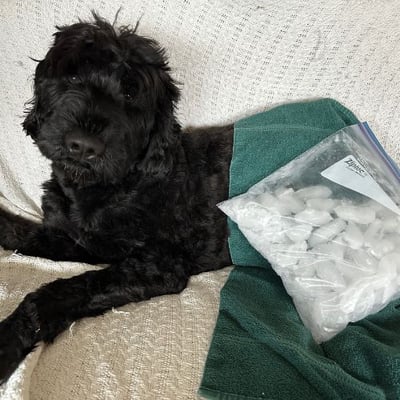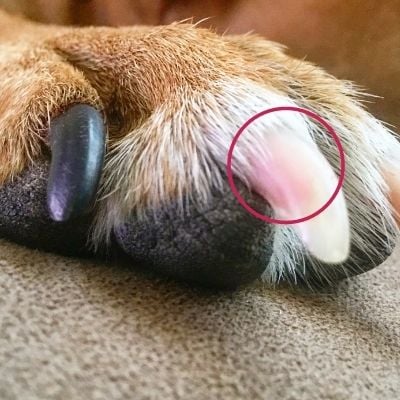 Maybe it's just me and my bad luck, but it always seems accidents or illnesses occur after normal doctor hours for my two- and four-legged family members.
Maybe it's just me and my bad luck, but it always seems accidents or illnesses occur after normal doctor hours for my two- and four-legged family members.
One is then left pondering the age-old question, “Can this wait until the morning for our regular doctor, or should we go to the emergency hospital?”
When your dog is having certain issues, such as seizures, weakness, breathing issues, bleeding, moderate to large open wounds, broken bones, and other serious problems, they need to be seen by a veterinarian IMMEDIATELY – you CANNOT ‘wait and see’ how they do. Then there are some problems, depending on your dog, that could potentially wait until the morning.
Depending on your dog and your ability to manage certain situations, limping may be one of those conditions you can take the ‘wait and see’ approach instead of rushing to the animal ER.
My goal is to help you assess which approach is the best option based on your dog and their symptoms.
Skip to section:
What to Do If Your Dog Is Limping
Reasons You Must Go to Emergency If Your Dog Is Limping
If your dog is suddenly limping and you notice any of the following conditions as well, please take them IMMEDIATELY to an animal emergency hospital:
- Bleeding
- Moderate to large open wound
- Significant swelling or edema (swelling involving water/liquid)
- Open or closed fracture (i.e., you notice an abnormal angulation of ANY bone of the leg) or broken bone (i.e., you can see the bone protruding through the skin)
- If your dog is clearly in discomfort or pain (panting, whining, anxious)
- Limping progresses to weakness or paralysis (complete or partial loss of the ability to move)
- Your dog appears to have no deep pain sensation
- Checking for deep pain requires two people. One to restrain the dog so they can’t bite (it's best to put an emergency muzzle on the dog first), while the other person strongly pinches the dog’s digits (toes) using their fingernails or tweezers.
If your dog doesn’t respond (trying to bite, crying or whining, turning their head toward the pinch, trying to get away), there may be the absence of deep pain. If your dog doesn’t act like it is being hurt but pulls their leg away, that doesn’t mean that deep pain isn’t present.
But if your dog doesn’t respond in any manner to the stimulus of being pinched, you must seek medical attention immediately. It could be a number of reasons, one of them being intervertebral disc disease (IVDD).
- Checking for deep pain requires two people. One to restrain the dog so they can’t bite (it's best to put an emergency muzzle on the dog first), while the other person strongly pinches the dog’s digits (toes) using their fingernails or tweezers.
- If any other symptoms develop with the limping
- Vomiting
- Diarrhea
- Lethargy
- Changes in behavior
- Decreased appetite or thirst
‘Wait and See’ Approach
If you have confidently determined that none of the above scenarios apply to your dog, then you may be able to wait and see how they do before heading to the vet right away. But even if your dog seems to improve, it is ALWAYS best to have them evaluated by their veterinarian.
Determine what is causing the limping
You need to determine why your dog is limping. Figuring out the cause helps you determine if your dog can wait for veterinary care as well as determine how you may be able to care for them until you take them to the veterinarian.
Safety First! When doing this, you must be VERY CAREFUL not to get bitten. Even though your dog may not act painful or scared, they very likely are. And while their intent isn’t to hurt you or anyone else, they may.
Ideally, having someone assist you is best. But fear not; you can still assess your dog if you are without help.
Whether you have help or not, you should place a muzzle on your dog. If you don't have one, you can create an emergency muzzle. Your main goal is to prevent them from opening their mouth.
Note: About 30 minutes prior to assessing your dog, you can spray the ‘emergency muzzle’ with ThunderEase (a calming pheromone) and give them a calming treat. Your assessment will be easier if they can relax even a little bit.
To properly assess your dog’s entire leg, you will need them to be as still as possible. You can have your dog lie down on their side with the affected leg on the upside. This is easier if you have help.
The other option is to have them stand next to a wall or sofa so they have some support while you are assessing their leg. Plus, the wall or sofa can help prevent them from moving, at least a little!
Begin your assessment
Remember to go slowly as you assess the leg. Watch for subtle indications of discomfort and pain, as this will help localize the cause. Assessing subtle signs is often easier with an assistant since it allows you to focus on the leg while they focus on the head and the rest of the body.
Some subtle reactions may be a:
- Slight muscle twitch or spasm
- Slight whimper or whine
- Head turn
- Changes in breathing or heart rate
- Mild jerk of the leg
Even if you find an issue as soon as you start checking your dog’s leg (e.g., an abnormal nail), be sure to check the entire leg since there may be more than one issue causing the limping.
One of our Preventive Vet team members is assessing her dog Finnegan in the video below. She didn't use a muzzle, but she didn't push further than his comfort zone.
In the video, you can see her gently pulling the leg back and forth to evaluate that her dog is able to flex and extend his joints normally, that there are no muscle spasms noted in the leg or back, and she is listening for any vocalization of pain. Brushing a relaxed leg and doing something the dog enjoys helps to determine where again he shows he doesn’t want her to touch.
As you watch, you can see the leg extends fully with no signs of pain, but when she goes around his toes, he licks and nibbles at the brush, so she stops. He squirms and pulls back, showing his discomfort only when the paw is touched or brushed. She assessed that his foot was the point of discomfort. He ended up being fine.
When he did go into the vet two days later (first thing on Monday morning), x-rays showed no fractures or broken bones. Even her vet thought something was gravely wrong with how high he was holding his leg (you can see this in the second video below). Please use extreme caution when evaluating your dog.
Is Your Dog Limping from a Nail Issue?
Look at each nail from all sides (don’t forget the dewclaws if they have them) and the nail beds. Some things to look for:
- Are any of the nails too long (the nail shouldn’t be past the bottom of their pad)?
- Are any of the nails missing?
- Are any of the nails broken, chipped, or peeling?
- Are any of the nails loose when touched?
- Are the nailbeds swollen? The nailbed is where the nail meets the paw pad.
- Are the nailbeds warm to the touch?
- Are the nailbeds missing fur?
- Are the nailbeds crusty or scaly looking?
- Is there any discharge (e.g., pus or blood) from the nailbed?
- Are there any signs of discomfort or pain when the nails and/or the nailbeds are touched or moved?
If you answer yes to any of these questions, the nails and/or nailbeds may be all or part of the issue. Continue checking the rest of the leg.
Is Your Dog Limping from an Issue With the Paw?
Check the entire paw. This includes all the pads in between the digits and the bones.
- Are there any foreign objects stuck in the pads or between the toes (thorns, rocks, glass, etc.)?
- Are any of the pads cut or have raw spots?
- Is there any blood on or near the pad?
- Are the margins of the pad (where the pad meets the fur) normal?
- Is the pad dry or chapped?
- Is there any sign of pain when you touch the pad?
- Are there any lumps/bumps between any of the toes?
- Is there any swelling between the toes?
- Is there any redness between the toes?
- Is there any odor between the toes?
- When the skin between the toes is touched, is there any sign of discomfort or pain?
- Are any of the digits (check each one individually, including the dewclaw area) swollen? Note: Sometimes, this is obvious, and other times it isn’t. If you are unsure, compare the toes of the affected paw to those of an unaffected paw.
- Is there any sign of discomfort or pain when the toe is touched? Note: To determine this, gently touch each toe from top to bottom and then flex and extend them.
- Is there any fur loss anywhere on the paw?
My Story:
From personal experience, I have learned to NEVER discount any paw issue. Years ago, my rescued Dobie began limping one day. I looked over his leg from the nails to his hip. The only thing I noted was a tiny scratch to his pad – not even enough to warrant antibiotics and certainly not pain meds. I figured there was NO WAY this would make him lame, but if it were a discomfort, he would be fine in a day or two.
When a few days passed, and he continued not to put any weight on the leg, I assumed I missed a cruciate tear or, being a negative Nelly, he had cancer. I was lucky to own my own veterinary clinic. I took him in, sedated him to better check his cruciate (around the knee joints), and took x-rays. I found nothing. I decided that I would give some pain meds for a few days just in case that tiny pad irritation was so painful for the poor fella. He was better within two days. The moral of the story is never assume your pet’s ability to tolerate discomfort or pain!!! They may get over it, but they may be telling you something.
Is Your Dog Limping from an Issue With One of the Long Bones of the Leg?
The long bones of the leg are the bones between the joints.
Look at the bones of the affected leg and compare them to the opposing normal leg. This is often easiest to do when your dog is standing in a room with good lighting.
Look for any cuts, abrasions, wounds, bruising, bumps/lumps, or hair loss.
Gently and slowly run your hands over the bones of each leg, starting at the top and working downward. You may have to repeat this a couple of times to note any differences between the affected leg and the ‘normal’ leg. As you are doing it, you want to attempt to feel for any muscle spasms, heat, mild swelling, or any other differences between the two legs.
After you have initially felt the long bones, gently go down them and softly squeeze every couple of inches and monitor for any signs of discomfort or pain (whining, yelping, head turning toward you, biting, pulling of the leg).
If all seems well, then this area is likely not part of the issue.
Is Your Dog Limping from an Issue With a Joint (carpus/hock or elbow/stifle, or hip)?
Once you are done assessing the other areas of the leg, it is time to assess the joints of the affected leg. If the front leg is affected, you will be checking the carpus (wrist) and the elbow, and the shoulder. On the back leg, you will be assessing the hock (ankle), the stifle (knee), and the hip.
- Is there any swelling (compared to the normal leg)?
- Is the joint warm to the touch?
- Is there any fur loss around the joint?
- Are there any signs of discharge (e.g., blood or pus)?
- Are there any small wounds/cuts, abrasions, or bruising? Note: To determine, especially on medium to long-haired dogs, you will need to separate the hairs and look between them carefully. Sometimes, using a little alcohol can help you part the fur.
- Are you able to gently and slowly flex and extend the joint fully, or is there resistance? This video demonstrates how to flex and extend each joint.
- Are there any signs of discomfort or pain when the joint is touched or moved?
What to Do Next After You Know Why Your Dog is Limping?
Hopefully, you have been able to determine the area of the leg that is causing your dog to limp. If not, that is ok too!
If you were not able to localize the cause, there are some things you can attempt to do to make your furry friend comfortable, but you will need to get your dog evaluated by a veterinarian as soon as possible.
- Restrict your dog’s activity. This means no running, jumping, or playing. Just short leash walks to go to the bathroom and back. Note: You may have to create a sling to help them walk if you have stairs and/or if they can’t balance on their own. You can use a towel or a canvas shopping bag; both demonstrated in this video.
- Ice the entire affected leg for 20 minutes for the next few hours (20 minutes on, 40 minutes off).
If it is the front leg, ice from the shoulder down to the tip of the toes. If it is the back leg, ice from the top of the hip to the tip of the toes. Be sure to place a thin towel between the ice and your dog’s body.
The purpose of the icing is to help decrease inflammation, swelling, and spasms which all help to lessen pain.
NOTE: If the limping issue started on a Friday or Saturday and you feel your dog is improving and can wait until Monday to be seen by a veterinarian, you will want to continue icing the leg three times per day for 20 minutes.
If it's a nail injury
If you determine that there is a nail and/or nailbed problem, there are a few things you can do to hopefully get your dog comfortable.
- If their nails seem even a little bit long, try to trim or file them. Even a little bit can make all the difference.
- If a nail is torn, broken, or missing and the ‘quick’ is showing (the soft tender ‘flesh’ below the nail), or the nailbeds appear swollen and/or irritated, you can soak the entire paw in warm water and Epsom salt for about 20 minutes. Rinse the entire paw well and dry.
Soaking should be repeated once to twice daily until your dog is evaluated by your veterinarian.
Apply some triple antibiotic ointment or sterile lubricant to the quick to keep it moist. If the nailbed is swollen due to an abrasion or small cut, ointment can be applied there too. Check out our article for more guidance on wound care.

Cover the ‘quick’ or nailbed with a gauze pad, then apply a bandage or a sock to keep the area covered.
NOTE: Do not apply the protective covering unless you know 100% your dog will not chew it off and eat it, or you have an Elizabethan Collar. You don’t need your dog dealing with an intestinal blockage on top of other things. If you are not able to use a bandage, attempt to at least cover the paw when going outside.NOTE: If you apply a bandage, be sure that it isn’t applied too tightly, or else you will cause further harm. Additionally, do not leave on a damp or wet bandage.
If it's a paw or paw pad injury
Here are some options on what to do based on some possibilities:
- If there is a foreign object, such as thorn, try to remove it. Do this slowly and carefully so that no pieces break off and remain in the pad or skin. If your dog resists, it is best to take them to the veterinarian right away before they develop an infection or create self-trauma trying to remove it themselves.
- If there is a cut or an abrasion, regardless of the size, soak in Epsom salt for about 20 minutes, and protect as recommended above for a torn toenail.
Note: Injuries to the pad are very slow to heal and, for some dogs, can be painful. While it isn’t an immediate emergency, you will want your veterinarian to check it sooner than later so that they can prescribe medications (either topical or oral). - If you suspect the injury is a ligament, tendon, or a bone of the paw, strictly confine your dog, ice it as recommended above, and be sure to have them seen by your veterinarian. Depending on the injury, your veterinarian may have to splint the paw to protect it so it can heal properly.
- If you suspect there is trauma to a joint, strictly confine your dog, ice the area as recommended and bring them to their veterinarian as soon as possible.
Joint injuries will require x-rays (often under sedation) to make a proper diagnosis so that proper treatment can be given. For example, if your dog has a small fracture near the joint (or within the carpus (wrist) or hock), it will be treated differently (possibly a cast or referral to an orthopedic surgeon) than if the cause is arthritis (this condition is managed, not cured). But nothing can be determined without a full physical exam and x-rays.
Canine Cranial Cruciate Ligament Tear
A common stifle (knee) joint injury that you should be aware of that causes limping is a cranial cruciate ligament tear. Your dog may ‘toe tap’ but not bear full weight on the leg. The leg often looks like it is turning into the body. They are unable to sit normally. This type of injury requires sedation so that the joint can be properly assessed and x-rayed.
Repair often requires referral to a veterinary orthopedic doctor. There are different surgical procedures (TPLO, TTA, Lateral fixation) that are used to ‘repair’ the issue.
Watch this video to learn some basics about how to determine if your dog has a torn CCL.
I hope that this article helps you and your dog. Best wishes for swift healing.



